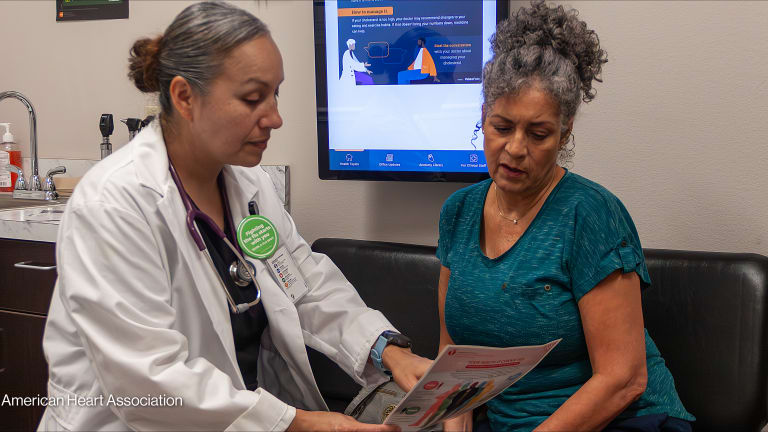
As the world’s population reaches the 7 billion mark, we know that the 7th billion infant just born is more likely to die from a noncommunicable disease than any other illness. NCDs — including cancer, cardiovascular disease, chronic respiratory disease and diabetes — cause more deaths than all other diseases combined; an estimated 36 million every year in total. And they strike hardest at the world’s low- and middle-income populations.
The devastating human cost of these diseases is coupled with a staggering economic cost due to lost productivity, foregone national income and rising health care costs. In just two decades, NCDs are estimated to cost the global economy $47 trillion, equivalent to eradicating $2-a-day poverty for more than half a century.
To combat this global health and development challenge, governments have adopted a series of bold commitments, including an ambitious goal to reduce premature NCD mortality by 25 percent by 2025. This acceleration in the political response gives those of us in the NCD community hope that our world leaders are now taking this issue seriously.
But how does the political response to NCDs dovetail with the much-talked-about concept of universal health coverage? UHC, defined as a situation where all people, everywhere, can access quality health services without incurring financial hardship, has been described as the single most powerful concept that public health has to offer, and a key instrument to enhancing sustainable human development.
Given the scale and geographic reach of NCDs, this epidemic poses both challenges and opportunities for the design and implementation of UHC. These are best understood by taking each of the three dimensions of UHC in turn: providing health services, covering populations and covering costs.
Providing health services
A key element of UHC is ensuring a core package of health services is available to the populations that need it. Today, universal access to affordable and high-quality essential medicines and technologies remains a distant reality in many countries. Millions of people worldwide with NCDs do not have access to lifesaving essential care.
In the case of diabetes, insulin was discovered more than 90 years ago. While for children in the developed world, Type 1 diabetes is no longer a death sentence, in sub-Saharan Africa, only 1 percent of children with the disease survive for 6 years after diagnosis.
The pathway to UHC represents a significant opportunity to rectify this if cost-effective, quality-assured NCD services are prioritized. Governments have the World Health Organization-endorsed essential package of NCDs services to guide prioritization with recommendations for simultaneous population-based and clinical interventions.
But providing essential NCD services is dependent on a well-functioning health system. And it is here that momentum on UHC provides a particular opportunity for NCDs — if health systems are reoriented and strengthened to respond to chronic conditions such as NCDs and multi-morbidities.
Too often, health systems in low- and middle-income countries are characterized by fragmented health services. For example, in 2009, the president of the International Diabetes Federation met a man with diabetes in Cambodia who told him, “I wish I had AIDS and not diabetes.” If he had AIDS, he could have been treated for free in a modern health facility. But since he had diabetes, no affordable health care was available and the cost of treatment was bankrupting his family.
UHC must drive a different type of health system that prioritizes prevention and patient education. Reorienting health systems to respond to chronic conditions would benefit patients with all diseases and conditions including AIDS and tuberculosis, and in the areas of maternal and child health.
Just as U.N. Secretary-General Ban Ki-moon said: “Success will come when we focus our attention and resources on people, not their illnesses; on health, not disease”.
Covering populations
Universal health coverage also provides a framework for addressing inequalities and ensuring that disparities in access, uptake, coverage and impact of health services are minimized across populations.
The NCD epidemic is rooted in disparities of vulnerability, risk, access to services and health outcomes. Social inequalities exist both within and between countries, with risk factors such as smoking and high blood pressure — often higher in groups with low socio-economic status — accounting for more than half of absolute inequalities in key NCD outcomes. We must reduce inequalities in the exposure to risk factors and end stigma and discrimination for people living with NCDs.
With its intrinsic focus on equity and human rights, UHC provides a powerful vehicle to accelerate progress on reducing inequalities in health and NCDs. The temptation to start with the “easiest-to-reach” populations must be avoided at all costs. Targeted interventions to vulnerable populations, such as indigenous people, women, children and the elderly, will be important from a NCD perspective. Drawing upon the lessons from the HIV and AIDS movement in reducing stigma and discrimination — through community-based approaches and patient networks, for example — will drive progress in UHC and the reduction of NCDs.
Covering costs
An effective health financing system is essential to fund universal health coverage and to cover the costs not only to the health system but also to individuals.
The NCD epidemic poses stark challenges to these functions. At the national level, NCDs are contributing to rising direct medical costs, which are draining health budgets. At the household level, people with NCDs are driven into chronic poverty by out-of-pocket payments for health care. Some 100 million people are forced into poverty annually due to exorbitant costs of NCDs in Africa alone.
For example, in Ghana the lowest-paid government worker will use 15 days’ wages to pay for one month of the lowest-price hypertension and diabetes treatment from a private pharmacy.
As governments embark on pathways to universal coverage, innovative financing mechanisms utilized within the NCD response can be harnessed to support resource mobilization. For example, taxation on unhealthy products — such as tobacco, alcohol, saturated fats and sugar-sweetened beverages — are particularly relevant. Tobacco taxation has been upheld as “the single most important opportunity for national governments worldwide to curb NCDs.”
Just last month in Moscow, most of the world’s countries adopted new guidelines on tobacco taxation which note that effective tobacco taxes significantly reduce tobacco consumption and prevalence, as well as being an important source of revenue.
Looking ahead to the post-2015 era
As the expiry date of the Millennium Development Goals approaches, there is growing consensus for a new global health agenda to be part of the post-2015 era, and to incorporate both chronic diseases and universal health coverage in the emerging global development framework.
There can be no doubt that UHC has the potential to unify a somewhat fragmented health agenda and ensure adequate attention to equity and human rights. But from a NCD perspective, it is equally important to ensure continued political priority for addressing the underlying social determinants that shape health and NCDs more profoundly. Action beyond the health sector is critical to meeting the “25 by 25” NCD mortality target, and to improving other health outcomes post-2015.
Want to learn more? Check out the Healthy Means campaign site and tweet us using #HealthyMeans.
Healthy Means is an online conversation hosted by Devex in partnership with Concern Worldwide, Gavi, GlaxoSmithKline, International Federation of Pharmaceutical Manufacturers & Associations, International Federation of Red Cross and Red Crescent Societies, Johnson & Johnson and the United Nations Population Fund to showcase new ideas and ways we can work together to expand health care and live better lives.
Read more #HealthyMeans articles:
● How to end a neocolonialist approach to global health training
● 3 ways the public sector can work with business to fight NCDs








